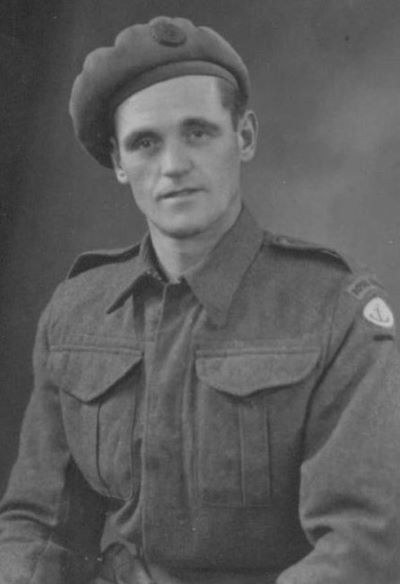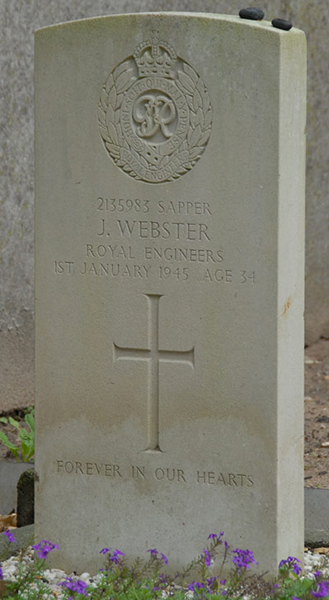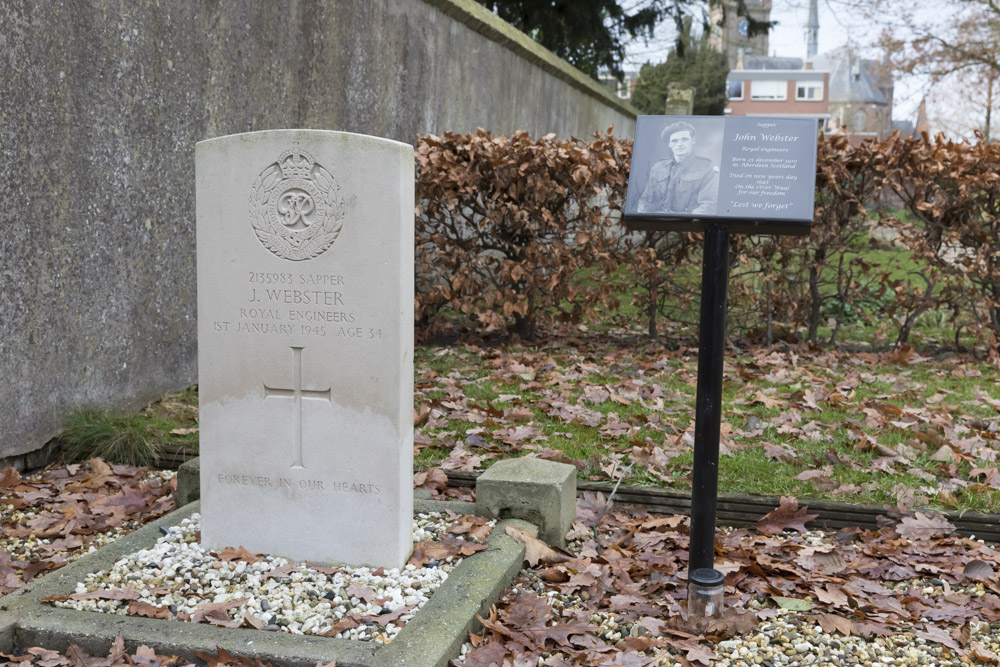Webster, John
- Date of birth:
- December 25th, 1910 (St. Nicholas, Aberdeen, Scotland, United Kingdom)
- Date of death:
- January 1st, 1945 (Deest, municipality of Druten)
- Buried on:
- Commonwealth War Grave Protestant Cemetery Druten
- Service number:
- 2135983
- Nationality:
- British
Biography
John Webster was born on 25th December 1910 in St. Nicholas, Aberdeen, in the Northeast of Scotland. He was the youngest of three children of John Webster and Williamina Barclay and had two elder sisters. He grew up in a hard working family. After elementary school he went into building/construction. He learned the building trade and mostly worked as a plasterer. As a young man he favored different sports, he loved football (soccer), was good at golf and an excellent swimmer.
He met his love Helen Wood Cameron in the dancing hall and married her in 1932. John and Helen had two children, daughter Sheila (1934) and son John (1942). He was ambitious and was planning to set up a building business with a close friend as partner, but the World War Two intervened.
In 1940 John joined the British Army and was assigned to the Royal Engineers. On June 6, 1944, he landed in Normandy during operation Overlord. His unit, 91st Field Company Royal Engineers, saw action in France and Belgium before going to the Netherlands in the Autumn of 1944. John was part of the 3rd platoon of that unit and arrived in that period of time in the ‘land of Maas and Waal’. His platoon was probably located in the village of Deest.
On January 1st, 1945, tragedy struck. It was clear weather that morning and it had frozen that night. John and five other sappers of his unit were on the river Waal, reportedly to inspect a floating barrier across the Waal, near to the shipyard of Deest. The barrier was part of the protective measures to defend the Waal bridges near Nijmegen against German attacks by water. A threat that proved to be very real on the night of 12 – 13 January when the Germans tried to attack the Waal bridges by Biber-submarines. In the morning of January 1st, 1945, Germany launched the Operation Bodenplatte, an large scale air campaign to attack the allied airfields in southern Netherlands, Belgium and North-France, in support of the stalled offensive in the Belgium Ardennes.
While John and his colleagues were working on the river, they were surprised by a large armada of low flying German aircraft. It remains unclear whether their boat suddenly turned over while the men ducked for the low flying planes or were shot at by these aircraft. It resulted in John and his five fellow sappers falling in the freezing water of the Waal that had a strong current. All six soldiers drowned. Johns body was found after a couple weeks on the south bank near Druten, after the thawing of the ice in the river. While one of his fellows remained missing, the other bodies were recovered at different locations along the riverbank of the Waal and buried and different locations.
Sapper John Webster is buried at the Protestant Cemetery in Druten. He was (posthumously) rewarded with the 1939-45 Star, the France and Germany Star, the Defence Medal and the War Medal 1939-1945.
Do you have more information about this person? Inform us!
- Period:
- Second World War (1939-1945)
- Rank:
- Sapper (Combat Engineer)
- Unit:
- 91st Field Company Royal Engineers
- Period:
- Second World War (1939-1945)
- Rank:
- Sapper (Combat Engineer)
- Period:
- Second World War (1939-1945)
- Rank:
- Sapper (Combat Engineer)
- Period:
- Second World War (1939-1945)
- Rank:
- Sapper (Combat Engineer)
Sources
- Photo 1: oorlogsslachtofferswestbetuwe.nl
- Photo 2: findagrave.com
- - Sapper John Webster (1910-1945) - Find a Grave-gedenkplek
- Aangespoeld in Druten jan. 1945 - Oorlogsslachtoffers uit Betuwe-West
- Aangespoeld in Haaften - Oorlogsslachtoffers West-Betuwe
- Biber-aanval op de Waalbrug bij Nijmegen, 12-13 januari 1945 - TracesOfWar.nl
- Timeline - TracesOfWar.nl
- https://www.oorlogsbronnen.nl/thema/Operatie Bodenplatte
- http://www.heemkundeverenigingleeuwen.nl/PDF/Oorlogsdagboek Gosselink.pdf
- Monument voor Engelse soldaat John Webster - Demaasenwaler.nl
- 91st Field Company, Royal Engineers in the Second World War 1939-1945 - The Wartime Memories Project -








